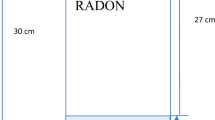Abstract
Radon (222Rn) is a carcinogenic gas produced by the radioactive decay of radium (226Ra). It has been reported that soil and soil-gas are primary factors that could cause indoor radon problems. Six sites were selected for this study—Sanbook, Gangcheon, Jikyeong, Choojung, Geumsung and Homyoung—each was classified according to bedrock type. In order to investigate soil-gas radon activities and radon emanating power, innovated active and passive detecting methods were developed and applied under both field and laboratory conditions. Statistical analysis of results confirmed that the radon activity values measured using either active or passive methods under field or laboratory conditions could be interchangeable with each other.




Similar content being viewed by others
References
Barretto, P. M. C. (1972). Physical characteristics of radon-222 emanation from rocks, soils and materials. In: The natural radiation environment II (pp. 731–740). National Technical Information Service: Springfield, US.
Gundersen, L. C. S., & Wanty, R. B. (1991). Field studies of radon in rocks, soils and Water. U.S. Geological Survey Bulletin 1971, 334 pp.
Kemski, J., Siehl, A., Valdivia-Manchego, M., & Lehmann, R. (1998). Comparison of radon concentrations in buildings in Oberfranken (Bavaria) with the geogenic radon potential. In I. Barnet & M. Neznal (Eds.), Proceeding of the fourth International Workshop on the Geological aspects of radon risk mapping (pp. 53–62). Prague, Czech Rep.
Kim, O. C., Kim, S. W., Ryou, B. H., & Park, B. K. (1974). Geological Map of Boeun sheet. Geological and mineral institute of Korea, 35 pp.
Lee, J. S. (1997). Dispersion and enrichment of potentially toxic elements in sites underlain by black shales and slates of the Okchon zone in Korea. Ph.D. thesis, Seoul National University.
Martino, S. D., Sabbarese, C., & Monetti, G. (1998). Radon emanation and exhalation rates from soils measured with an electrostatic collector. Applied Radiation Isotopes, 49(4), 407–413.
Miles, J. (1996). Mapping radon-prone sites by lognormal modeling of house radon data. Health Physics, 74(3), 370–378.
Morse, R. H. (1976). Radon counters in uranium exploration. I.A.E.A.-N.E.A. International Symposium on the Exploration of Uranium Ore Deposits. Vienna. I.A.E.A. pub. No. IAEA-SM-208/55.
Thompkins, R. W. (1982). Radiation in uranium mines. CIM Bulletin September 1982 (pp. 149–156).
Wilkening, M. (1990). Radon in the environment. Elsevier, 137 pp.
Acknowledgements
This research was supported by the Ministry of Environment and the Korea Institute of Environmental Science and Technology (KIEST) as “The Eco-technopia 21 project (2005-09001-0022-0)”.
Author information
Authors and Affiliations
Corresponding author
Rights and permissions
About this article
Cite this article
Je, HK., Kang, CG., Choi, JY. et al. Assessment of soil and soil-gas radon activity using active and passive detecting methods in Korea. Environ Geochem Health 29, 295–301 (2007). https://doi.org/10.1007/s10653-007-9098-9
Published:
Issue Date:
DOI: https://doi.org/10.1007/s10653-007-9098-9




